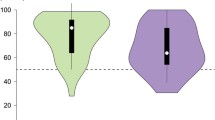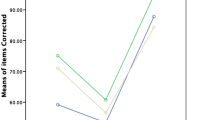Abstract
The hypothesis about the association of dyslexia with visual-spatial talents is still not verified. Evidence is inconsistent, ranging from inferior to superior visual-spatial abilities in individuals with dyslexia. Using a variety of visual-spatial tasks, this study tested the hypothesis that dyslexia is associated with superior visual-spatial ability. The results suggest that children with dyslexia performed equivalently to the controls on most tasks. On one measure, however, they were superior. They were significantly better than controls on the analytic spatial test. Results also showed that they were worse in solving visual-spatial tasks that include implicit memory.
Similar content being viewed by others
References
Akshoomoff, N. A., Feroleto, C. C., Doyle, R. E., & Stiles, J. (2002). The impact of early unilateral brain injury on perceptual organization and visual memory. Neuropsychologia, 40, 539–561.
American Psychiatric Association. (1994). Diagnostic and statistical manual of mental disorders (4th ed.). Washington, DC: Author.
Attree, E. A., Turner, M. J., & Cowell, N. (2009). A virtual reality test identifies the visuospatial strengths of adolescents with dyslexia. Cybernetics Psychology and Behavior, 12(2), 163–8.
Bacon, A. M., & Handley, S. J. (2010). Dyslexia and reasoning: the importance of visual processes. British Journal of Psychology, 101(Pt 3), 433–52.
Biro, M. (1987). Test vizuelnog pamćenja (Test of visual memory). Beograd: Savez drustava psihologije SR Srbije.
Brunswick, N., Martin, G. N., & Marzano, L. (2010). Visuospatial superiority in developmental dyslexia: myth or reality? Learning and Individual Differences, 20(5), 421–426.
Cahn, D. A., Marcottelr, A. C., Stern, R. A., Arruda, J. E., Akshoomoff, N. A., & Leshko, I. C. (1996). The boston qualitative scoring system for the Rey-osterrieth complex figure: a study of children with attention deficit hyperactivity disorder. The Clinical Neuropsychologist, 10(4), 397–406.
Clark, S. K. (1999). Effect of spatial perception level and gender using Two and three dimensional graphics. PAACE Journal of Lifelong Learning, 8, 53–67.
Cooper, L. A., & Shepard, R. N. (1973). The time required to prepare for a rotated stimulus. Memory and Cognition, 1, 246–250.
Corballis, M. C., Macadie, L., & Beale, I. L. (1985). Mental rotation and visual laterality in normal and reading disabled children. Cortex a Journal Devoted to the Study of the Nervous System and Behavior, 21(2), 225–236.
Djuric, T. R. (1981). Test vizuelne percepcije „Elektricna mreza“(Test of Visual Perception „Electric grid). Beograd: Savez drustava psihologa Srbije.
Duranovic, M. (2013). Test za procjenu disleksije (Dyslexia Screening Test). In M. Duranovic & Z. Mrkonjic (Eds.), Procjena disleksije (Dyslexia Assessment). Tuzla: Print-Com.
Ekstrom, R. B., French, J. W., Harman, H. H., & Dermen, D. (1976). Kit of factor referenced cognitive tests. Princeton: Educational Testing Service.
Fajgelj, S., Bala, G., & Tubic, T. (2007). Ravenove progresivne matrice u boji—osnovna merna svojstva i norme. (Raven’s coloured progressive matrices - the basic measuring properties and norms). Psihologija, 40(2), 293–308.
Fawcett, A. J., & Nicolson, R. I. (1995). Persistent deficits in motor skill for children with dyslexia. Journal of Motor Behavior, 27, 235–240.
Fischer, B., Hartnegg, K., & Mokler, A. (2000). Dynamic visual perception of dyslexic children. Perception, 29(5), 523–30.
Folbrecht, J. R., Charter, R. A., Walden, D. K., & Dobbs, S. M. (1999). Psychometric properties of the Boston qualitative scoring system for the Rey-osterrieth complex figure. The Clinical Neuropsychologist, 13(4), 442–449.
Geschwind, N., & Galaburda, A. (1987). Cerebral lateralitation. Cambridge: MIT Press.
Griffin, J. R., Birch, T. F., Bateman, G. F., & De Land, P. N. (1993). Dyslexia and visual perception: is there a relation? American Journal of Optometry and Physiological Optics, 70(5), 374–9.
Hegarty, M., Shah, P., & Miyake, A. (2000). Constraints on using the dual-task methodology to specify the degree of central executive involvement in cognitive tasks. Memory & Cognition, 28, 376–385.
Karadi, K., Kovacs, B., Szepesi, T., Szabo, I., & Kallai, J. (2001). Egocentric mental rotation in Hungarian dyslexic children. Dyslexia, 7(1), 3–11.
Koenig, O., Kosslyn, S. M., & Wolff, P. (1991). Mental imagery and dyslexia: a deficit in processing multipart visual objects? Brain and Language, 41, 381–394.
Linn, M. C., & Petersen, A. C. (1985). Emergence and characterization of sex differences in spatial ability: a meta-analysis. Child Development, 56(6), 1479–98.
Lipowska, M., Czaplewska, E., & Wysocka, A. (2011). Visuospatial deficits of dyslexic children. Medical Science Monitor, 17(4), CR216–CR221.
Maccoby, E. E., & Jacklin, C. N. (1974). The psychology of sex differences. Stanford: Stanford University Press.
Miyake, A., Friedman, N. P., Rettinger, D. A., Shah, P., & Hegarty, M. (2001). How are visuospatial working memory, executive functioning, and spatial abilities related? A latent-variable analysis. Journal of ExperimentalPsychology: General, 130, 621–640.
Morris, R., Stuebing, K., Fletcher, J., Shaywitz, S., Lyon, G. R., Shankweiler, D., et al. (1998). Subtypes of reading disability: coherent variability around a phonological core. Journal of Educational Psychology, 90, 3, 347–373.
Nourbakhsh, S., Mansor, M., Baba, M., & Madon, Z. (2013). The effects of multisensory method and cognitive skills training on perceptual performance and reading ability among dyslexic students in Tehran-Iran. International Journal of Psychological Studies, 5(2), 92–99.
Osterrieth, P. A. (1944). Le test de copie d’une figure complexe: contribution a l’étude de la perception et de la memoire [copying a complex figure: contributions to the study of perception and memory]. Archives de Psychologie, 30, 203–353.
Peters, M., Chisholm, P., & Laeng, B. (1994). Spatial ability, student gender, andacademic performance. Journal of Engineering Education, 83(1), 1–5.
Raven, M. S. (1956). Uputstvo za korišćenje Progresivnih matrica u boji (Instructions for the use of colored progressive matrices). Beograd: Centar za primenjenu psihologiju.
Rey, A. (1941). L’examen psychologique dans les cas d’encéphalopathie traumatique (The psychological examination of cases of traumatic encephalopathy). Archives de Psycholige, 37, 126–139.
Rusiak, P., Lachmann, T., Jaskowski, P., & van Leeuwen, C. (2007). Mental rotation of letters and shapes in developmental dyslexia. Perception, 36, 617–631.
Russeler, J., Scholz, J., Jordan, K., & Quaiser-Pohl, C. (2005). Mental rotation of letters, pictures, and three-dimensional objects in German dyslexic children. Child Neuropsychology: a Journal on Normal and Abnormal Development in Childhood and Adolescence, 11(6), 497–512.
Shepard, R. N., & Metzler, J. (1971). Mental rotation of three-dimensional objects. Science, 171, 701–703.
Shiina, K., Saito, T., & Suzuki, K. (1997). Analysis of problem solving process of a mental rotations test - performance in shepard-metzler tasks. Journal for Geometry and Graphics, 1(2), 185–193.
Showman, M. M., & Ahissar, M. (2006). Isolating the impact of visual perception on dyslexics’ reading ability. Vision Research, 46, 3514–3525.
Siegel, L. S., & Ryan, E. B. (1989). Subtypes of developmental dyslexia: the influence of definitional variables. Reading and Writing: An Interdisciplinary Journal, 2, 257–287.
Sigmundsson, H. (2005). Do visual processing deficits cause problem on response time task for dyslexics? Brain and Cognition, 58(2), 213–216.
Spreen, O., & Strauss, E. A. (1998). Compendium of neuropsychological tests. Administration, norms and commentary (2nd ed.). New York: Oxford University Press.
Stern, R. A., Singer, E. A., Duke, L. M., Singer, N. G., Morey, C. E., Daughtrey, E. W., & Kaplan, E. (1994). The Boston qualitative scoring system for the Rey-osterrieth complex figure: description and interrater reliability. The Clinical Neuropsychologist, 8, 309–322.
Swanson, H. L. (1984). Semantic and visual memory codes in learning disabled readers. Journal of Experimental Child Psychology, 37, 124–140.
Vandenberg, S. G., & Kuse, A. R. (1978). Mental rotations, a group test of three-dimensional spatial visualization. Perceptual and Motor Skills, 47, 599–601.
von Karolyi, C. (2001). Visual-spatial strength in dyslexia: rapid discrimination of impossible figures. Journal of Learning Disabilities, 34(4), 380–391.
von Karolyi, C., & Winner, E. (2005). Investigations of visual-spatial abilities in dyslexia. In F. Columbus (Ed.), Focus on dyslexia research (pp. 1–25). Hauppauge,: Nova Science.
von Karolyi, C., Winner, E., Gray, W., & Sherman, G. F. (2003). Dyslexia linked to talent: global visual-spatial ability. Brain and Language, 85(3), 427–431.
Wang, L. C., & Yang, H. M. (2011). The comparison of the visuo-spatial abilities of dyslexic and normal students in Taiwan and Hong Kong. Research in Developmental Disabilities, 32(3), 1052–7.
West, T. (1997). In the mind’s eye: visual thinkers, gifted people with dyslexia and other learning difficulties, computer images, and the ironies of creativity. Amherst: Prometheus.
West, T. G. (2005). The gifts of dyslexia: talents among dyslexics and their families. Hong Kong Journal of Paediatrics, 10, 153–158.
Winner, E., Casey, M. B., DaSilva, D., & Hayes, R. (1991). Spatial abilities and reading deficits in visual art students. Empirical Studies of the Arts, 9(1), 51–63.
Winner, E., von Karolyi, C., & Malinsky, D. (2000). Dyslexia and visual-spatial talents: no clear link. International Dyslexia Association Newsletter, 27–30.
Winner, E., von Karolyi, C., Malinsky, D., French, L., Seliger, C., Ross, E., & Weber, C. (2001). Dyslexia and visual-spatial talents: compensation vs deficit model. Brain and Language, 76(2), 81–110.
Wolf, U., & Lundberg, I. (2002). The prevalence of dyslexia among art students. Dyslexia, 8, 34–42.
Author information
Authors and Affiliations
Corresponding author
Rights and permissions
About this article
Cite this article
Duranovic, M., Dedeic, M. & Gavrić, M. Dyslexia and Visual-Spatial Talents. Curr Psychol 34, 207–222 (2015). https://doi.org/10.1007/s12144-014-9252-3
Published:
Issue Date:
DOI: https://doi.org/10.1007/s12144-014-9252-3




